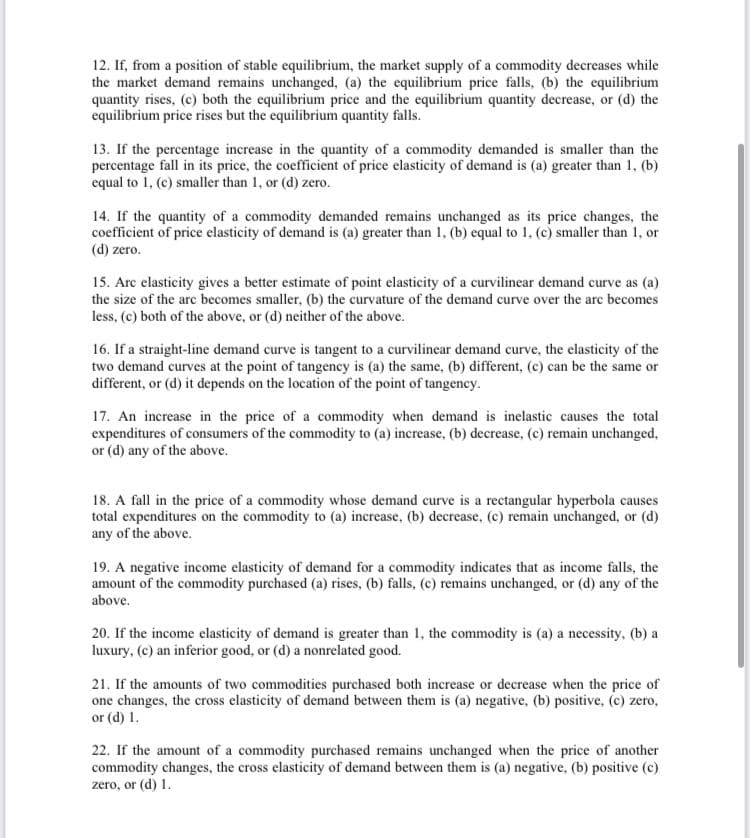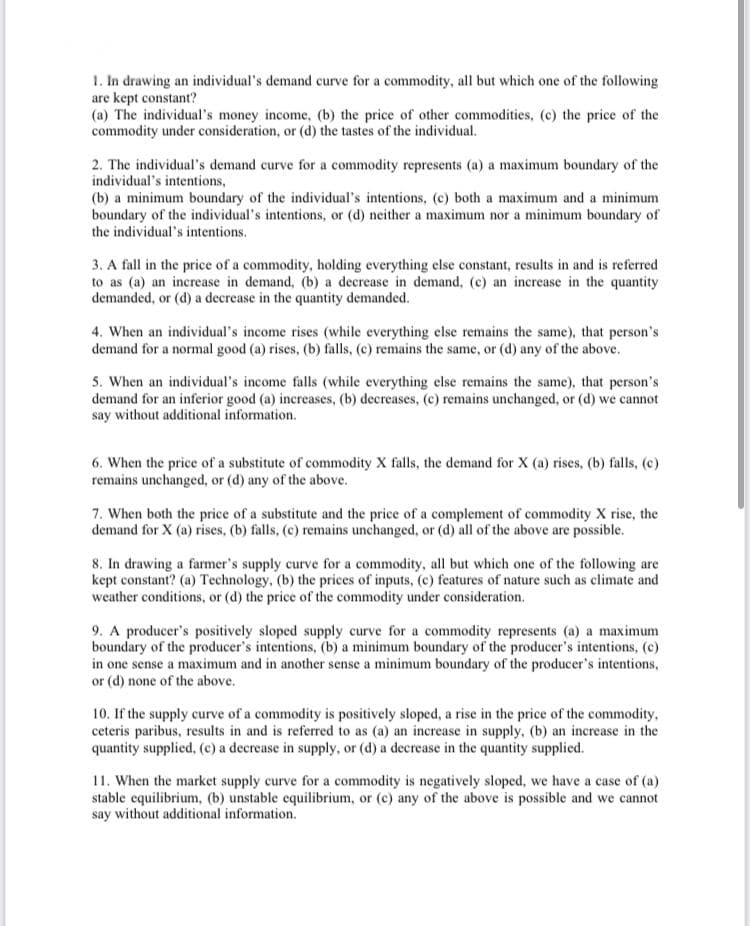1. In drawing an individual's demand curve for a commodity, all but which one of the following are kept constant? (a) The individual's money income, (b) the price of other commodities, (c) the price of the commodity under consideration, or (d) the tastes of the individual. 2. The individual's demand curve for a commodity represents (a) a maximum boundary of the individual's intentions, (b) a minimum boundary of the individual's intentions, (c) both a maximum and a minimum boundary of the individual's intentions, or (d) neither a maximum nor a minimum boundary of the individual's intentions. 3. A fall in the price of a commodity, holding everything else constant, results in and is referred to as (a) an increase in demand, (b) a decrease in demand, (c) an increase in the quantity demanded, or (d) a decrease in the quantity demanded. 4. When an individual's income rises (while everything else remains the same), that person's demand for a normal good (a) rises, (b) falls, (c) remains the same, or (d) any of the above. 5. When an individual's income falls (while everything else remains the same), that person's demand for an inferior good (a) increases, (b) decreases, (c) remains unchanged, or (d) we cannot say without additional information. 6. When the price of a substitute of commodity X falls, the demand for X (a) rises, (b) falls, (c) remains unchanged, or (d) any of the above. 7. When both the price of a substitute and the price of a complement of commodity X rise, the demand for X (a) rises, (b) falls, (c) remains unchanged, or (d) all of the above are possible. 8. In drawing a farrmer's supply curve for a commodity, all but which one of the following are kept constant? (a) Technology, (b) the prices of inputs, (c) features of nature such as climate and weather conditions, or (d) the price of the commodity under consideration. 9. A producer's positively sloped supply curve for a commodity represents (a) a maximum boundary of the producer's intentions, (b) a minimum boundary of the producer's intentions, (c) in one sense a maximum and in another sense a minimum boundary of the producer's intentions, or (d) none of the above. 10. If the supply curve of a commodity is positively sloped, a rise in the price of the commodity, ceteris paribus, results in and is referred to as (a) an increase in supply, (b) an increase in the quantity supplied, (c) a decrease in supply, or (d) a decrease in the quantity supplied. 11. When the market supply curve for a commodity is negatively sloped, we have a case of (a) stable equilibrium, (b) unstable equilibrium, or (c) any of the above is possible and we cannot say without additional information.
1. In drawing an individual's demand curve for a commodity, all but which one of the following are kept constant? (a) The individual's money income, (b) the price of other commodities, (c) the price of the commodity under consideration, or (d) the tastes of the individual. 2. The individual's demand curve for a commodity represents (a) a maximum boundary of the individual's intentions, (b) a minimum boundary of the individual's intentions, (c) both a maximum and a minimum boundary of the individual's intentions, or (d) neither a maximum nor a minimum boundary of the individual's intentions. 3. A fall in the price of a commodity, holding everything else constant, results in and is referred to as (a) an increase in demand, (b) a decrease in demand, (c) an increase in the quantity demanded, or (d) a decrease in the quantity demanded. 4. When an individual's income rises (while everything else remains the same), that person's demand for a normal good (a) rises, (b) falls, (c) remains the same, or (d) any of the above. 5. When an individual's income falls (while everything else remains the same), that person's demand for an inferior good (a) increases, (b) decreases, (c) remains unchanged, or (d) we cannot say without additional information. 6. When the price of a substitute of commodity X falls, the demand for X (a) rises, (b) falls, (c) remains unchanged, or (d) any of the above. 7. When both the price of a substitute and the price of a complement of commodity X rise, the demand for X (a) rises, (b) falls, (c) remains unchanged, or (d) all of the above are possible. 8. In drawing a farrmer's supply curve for a commodity, all but which one of the following are kept constant? (a) Technology, (b) the prices of inputs, (c) features of nature such as climate and weather conditions, or (d) the price of the commodity under consideration. 9. A producer's positively sloped supply curve for a commodity represents (a) a maximum boundary of the producer's intentions, (b) a minimum boundary of the producer's intentions, (c) in one sense a maximum and in another sense a minimum boundary of the producer's intentions, or (d) none of the above. 10. If the supply curve of a commodity is positively sloped, a rise in the price of the commodity, ceteris paribus, results in and is referred to as (a) an increase in supply, (b) an increase in the quantity supplied, (c) a decrease in supply, or (d) a decrease in the quantity supplied. 11. When the market supply curve for a commodity is negatively sloped, we have a case of (a) stable equilibrium, (b) unstable equilibrium, or (c) any of the above is possible and we cannot say without additional information.
Chapter6: Demand Relationships Among Goods
Section: Chapter Questions
Problem 6.9P
Related questions
Question
choose the best answer

Transcribed Image Text:12. If, from a position of stable equilibrium, the market supply of a commodity decreases while
the market demand remains unchanged, (a) the equilibrium price falls, (b) the equilibrium
quantity rises, (c) both the equilibrium price and the equilibrium quantity decrease, or (d) the
equilibrium price rises but the equilibrium quantity falls.
13. If the percentage increase in the quantity of a commodity demanded is smaller than the
percentage fall in its price, the coefficient of price elasticity of demand is (a) greater than 1, (b)
equal to 1, (c) smaller than 1, or (d) zero.
14. If the quantity of a commodity demanded remains unchanged as its price changes, the
coefficient of price elasticity of demand is (a) greater than 1, (b) equal to 1, (c) smaller than 1, or
(d) zero.
15. Arc elasticity gives a better estimate of point elasticity of a curvilinear demand curve as (a)
the size of the arc becomes smaller, (b) the curvature of the demand curve over the arc becomes
less, (c) both of the above, or (d) neither of the above.
16. If a straight-line demand curve is tangent to a curvilinear demand curve, the elasticity of the
two demand curves at the point of tangency is (a) the same, (b) different, (c) can be the same or
different, or (d) it depends on the location of the point of tangency.
17. An increase in the price of a commodity when demand is inelastic causes the total
expenditures of consumers of the commodity to (a) increase, (b) decrease, (c) remain unchanged,
or (d) any of the above.
18. A fall in the price of a commodity whose demand curve is a rectangular hyperbola causes
total expenditures on the commodity to (a) increase, (b) decrease, (c) remain unchanged, or (d)
any of the above.
19. A negative income elasticity of demand for a commodity indicates that as income falls, the
amount of the commodity purchased (a) rises, (b) falls, (c) remains unchanged, or (d) any of the
above.
20. If the income elasticity of demand is greater than 1, the commodity is (a) a necessity, (b) a
luxury, (c) an inferior good, or (d) a nonrelated good.
21. If the amounts of two commodities purchased both increase or decrease when the price of
one changes, the cross elasticity of demand between them is (a) negative, (b) positive, (c) zero,
or (d) 1.
22. If the amount of a commodity purchased remains unchanged when the price of another
commodity changes, the cross elasticity of demand between them is (a) negative, (b) positive (c)
zero, or (d) 1.

Transcribed Image Text:1. In drawing an individual's demand curve for a commodity, all but which one of the following
are kept constant?
(a) The individual's money income, (b) the price of other commodities, (c) the price of the
commodity under consideration, or (d) the tastes of the individual.
2. The individual's demand curve for a commodity represents (a) a maximum boundary of the
individual's intentions,
(b) a minimum boundary of the individual's intentions, (c) both a maximum and a minimum
boundary of the individual's intentions, or (d) neither a maximum nor a minimum boundary of
the individual's intentions.
3. A fall in the price of a commodity, holding everything else constant, results in and is referred
to as (a) an increase in demand, (b) a decrease in demand, (c) an increase in the quantity
demanded, or (d) a decrease in the quantity demanded.
4. When an individual's income rises (while everything else remains the same), that person's
demand for a normal good (a) rises, (b) falls, (c) remains the same, or (d) any of the above.
5. When an individual's income falls (while everything else remains the same), that person's
demand for an inferior good (a) increases, (b) decreases, (c) remains unchanged, or (d) we cannot
say without additional information.
6. When the price of a substitute of commodity X falls, the demand for X (a) rises, (b) falls, (c)
remains unchanged, or (d) any of the above.
7. When both the price of a substitute and the price of a complement of commodity X rise, the
demand for X (a) rises, (b) falls, (c) remains unchanged, or (d) all of the above are possible.
8. In drawing a farmer's supply curve for a commodity, all but which one of the following are
kept constant? (a) Technology, (b) the prices of inputs, (c) features of nature such as climate and
weather conditions, or (d) the price of the commodity under consideration.
9. A producer's positively sloped supply curve for a commodity represents (a) a maximum
boundary of the producer's intentions, (b) a minimum boundary of the producer's intentions, (c)
in one sense a maximum and in another sense a minimum boundary of the producer's intentions,
or (d) none of the above.
10. If the supply curve of a commodity is positively sloped, a rise in the price of the commodity,
ceteris paribus, results in and is referred to as (a) an increase in supply, (b) an increase in the
quantity supplied, (c) a decrease in supply, or (d) a decrease in the quantity supplied.
11. When the market supply curve for a commodity is negatively sloped, we have a case of (a)
stable equilibrium, (b) unstable equilibrium, or (c) any of the above is possible and we cannot
say without additional information.
Expert Solution
This question has been solved!
Explore an expertly crafted, step-by-step solution for a thorough understanding of key concepts.
This is a popular solution!
Trending now
This is a popular solution!
Step by step
Solved in 2 steps

Knowledge Booster
Learn more about
Need a deep-dive on the concept behind this application? Look no further. Learn more about this topic, economics and related others by exploring similar questions and additional content below.Recommended textbooks for you


Principles of Economics 2e
Economics
ISBN:
9781947172364
Author:
Steven A. Greenlaw; David Shapiro
Publisher:
OpenStax



Principles of Economics 2e
Economics
ISBN:
9781947172364
Author:
Steven A. Greenlaw; David Shapiro
Publisher:
OpenStax
